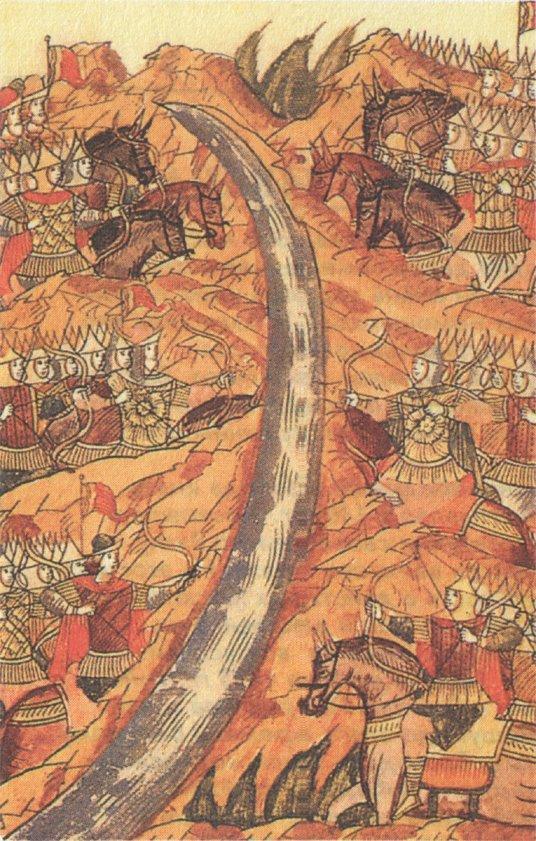Standing on the Ugra River. 1480. Miniature in Russian chronicle. XVI century.
The decisive moment of the defensive campaign led by Ivan III against the horde of Khan Ahmad, in October-November 1480.
Relations between the Great Horde and Moscow entered a crisis in the 1470s. Ivan III refused to acknowledge the sovereignty of Akhmad or to pay him tribute. Entering into an anti-Muscovite alliance with the grand prince of Lithuania and the Polish King Casimir, Ahmad started to campaign in the late spring of 1480. Ivan III adopted defensive tactics: In July he marched to the town of Kolomna and ordered his troops to guard the bank of the Oka River, but Ahmad made no attempt to force the Oka; instead he moved westward to the Ugra River where he hoped to meet his ally, King Casimir. The latter, however, never came.
For several months both sides temporized, and only in October did fighting break out. Muscovite troops, led by Ivan’s III son Ivan and brother Andrew, repulsed several Tatar attempts to cross the Ugra. Clashes alternated with negotiations which, however, met with no success. Finally, on November 11, 1480, the khan withdrew, thus acknowledging the failure of his attempt to restore his lordship over Rus.
In Russian historical tradition this event is celebrated as the end of the Mongol yoke. The roots of this tradition date back to the 1560s, when anonymous author of the so-called Kazan History wrote of the dissolution of the Horde after the death of Ahmad (1481) and hailed the liberation of the Russian lands from the Moslem yoke and slavery. In modern historiography, Nikolai Karamzin was the first to link the liberation with the events of 1480. Later, Soviet publications echoed this view. Another judgment of the same events was pronounced by the famous nineteenth-century Russian historian, Sergei Soloviev, who ascribed the downfall of the yoke not to the heroic deeds of Ivan III but to the growing weakness of the Horde itself. The same argument was put forward by George Vernadsky (1959), who maintained that Rus freed itself from dependence on the Horde not in 1480 but much earlier, in the 1450s. In Anton Anatolevich Gorskii’s view, the liberation should be dated not to 1480 but to 1472, when Ivan III stopped paying tribute to the khan.
Military aspects of the 1480 event also remain controversial. Some scholars consider the battle a large-scale military operation and honor the strategic talent of Ivan III; but others stress his hesitations or even deny that any battle took place, referring to the events of 1480 as merely the “Stand on the Ugra River” (Halperin, 1985).
This is the Great Standing on the Ugra in 1480 Monument. The inscription on the monument reads: The Great Stand on the Ugra river was at this place and Tataro-Mongol yoke in Russia was ended here.
BIBLIOGRAPHY Halperin, Charles. (1985). Russia and the Golden Horde: The Mongol Impact on Medieval Russian History. Bloomington: Indiana University Press. Vernadsky, George. (1959). Russia at the Dawn of the Modern Age. New Haven, CT: Yale University Press
